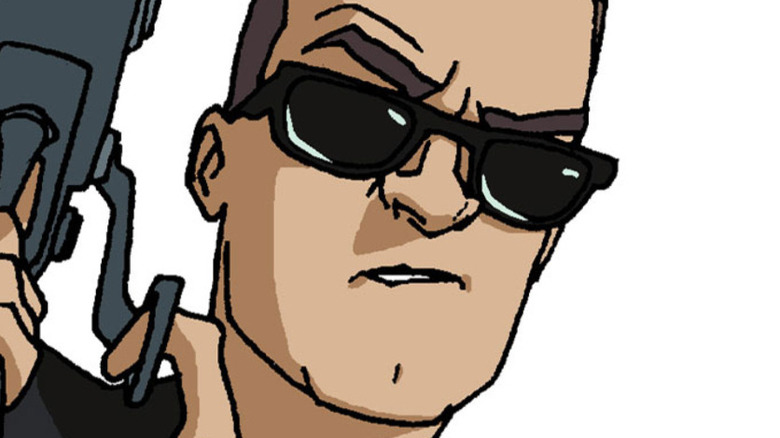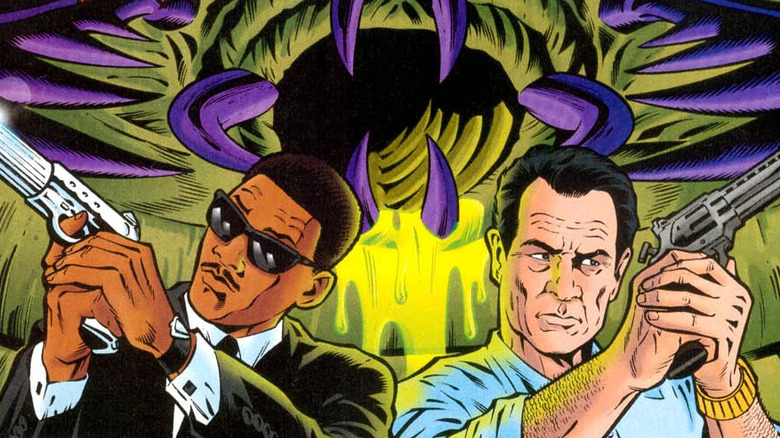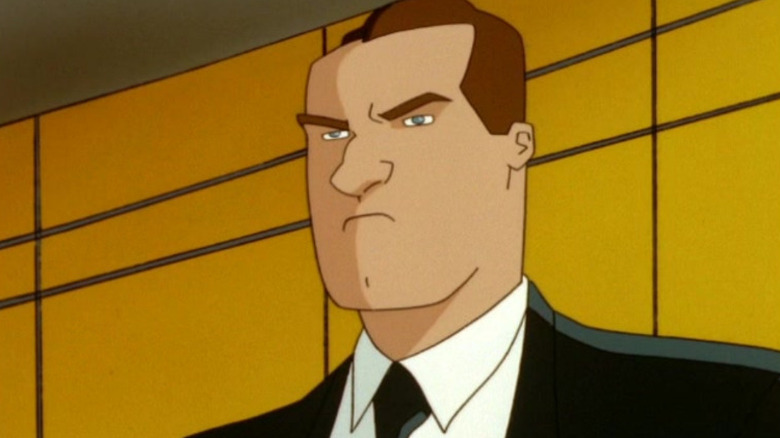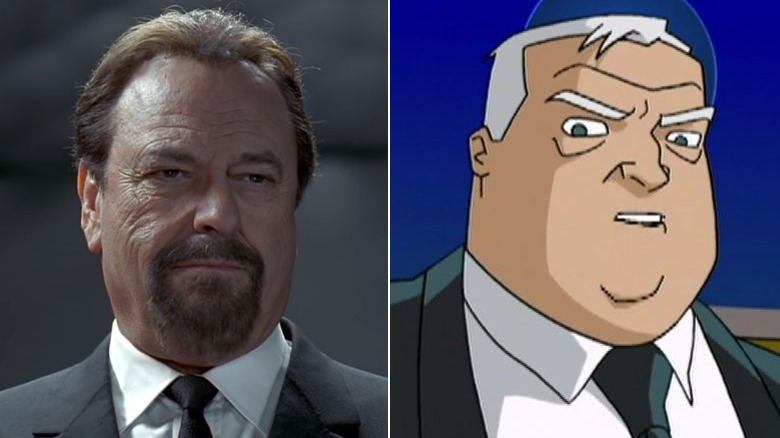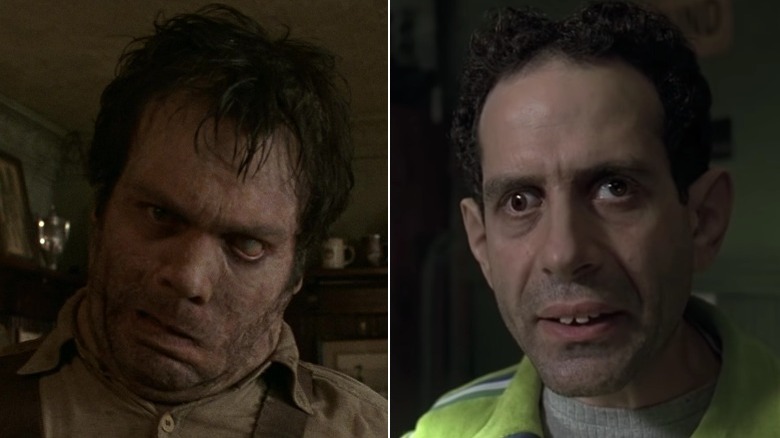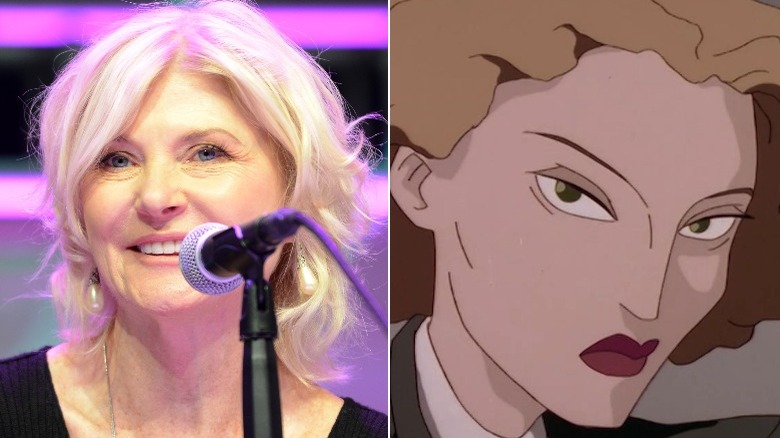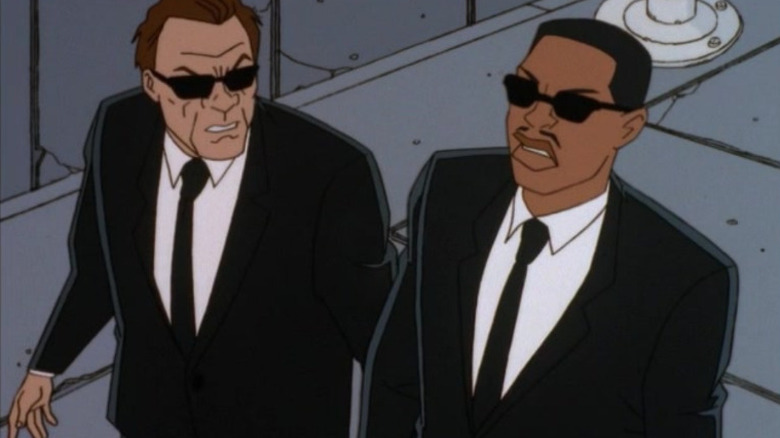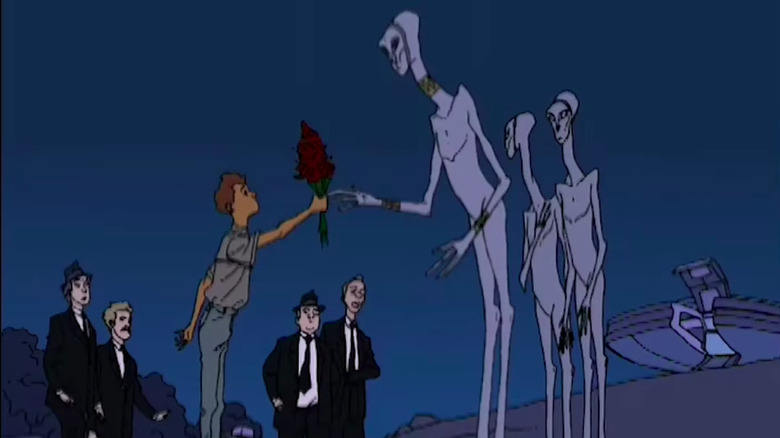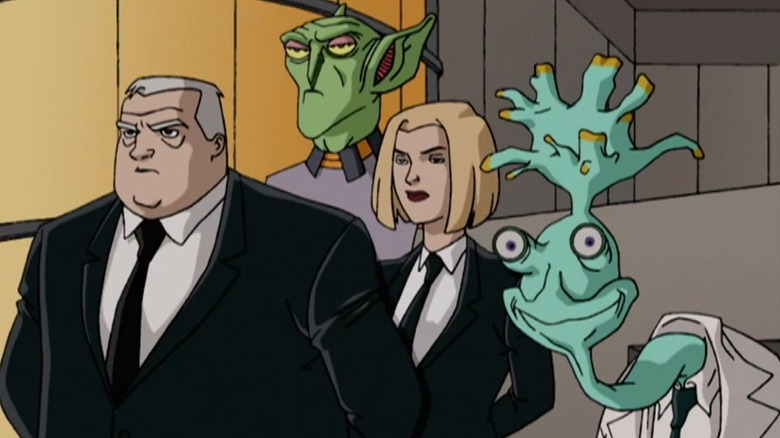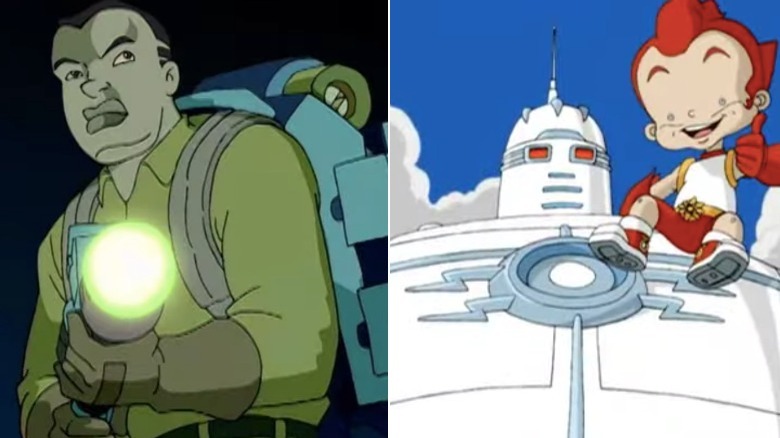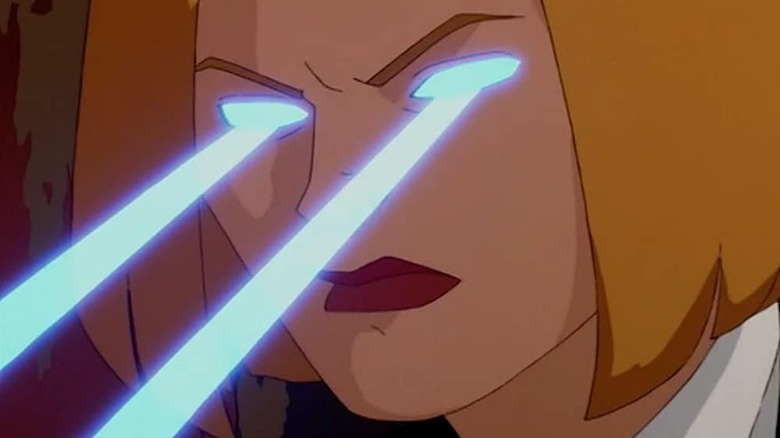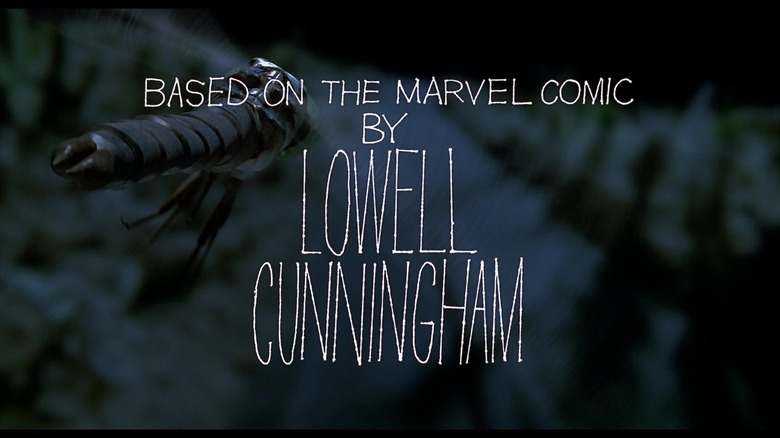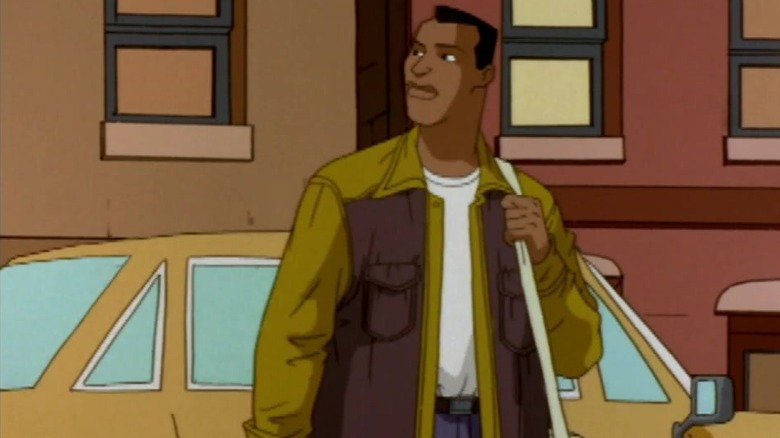The Untold Truth Of Men In Black: The Series
"Men in Black" may not have gotten its first movie sequel until 2002, but fans didn't have to wait long to see Earth's smartly dressed defenders again thanks to a little cartoon called "Men in Black: The Series." Debuting in October of 1997 — and thus, like the film, also turning 25 in 2022 — the show was one of many animated adaptations of popular live action movies created by Adelaide Productions and one of the company's most successful endeavors. The animated adventures of Agents J and K lasted a healthy four years and scored killer ratings along with resounding approval from the network that aired it in the U.S., Kids' WB. "MIB: The Series" wisely chose not to oversimplify things for its younger viewers, staying remarkably true to the tone of the movie and delivering smart, funny sci-fi stories on a regular basis.
Given that the series ended more than 20 years ago and hasn't re-aired in a ton of places since then, you could be forgiven if your memory of the show is a bit rusty, especially if you've been anywhere near a Neuralyzer lately. Even if you recall the series with crystal clarity, there may still be some interesting behind-the-scenes facts you may not be aware of. So set your watches to Centaurian time, keep your Noisy Cricket handy, try not to get any Skraaldian puke on you, and prepare for the untold truth of "Men in Black: The Series."
The comic that's almost a prequel
"Men in Black: The Series" doesn't quite return to the status quo set up at the end of the first "Men in Black" movie. For one, Agent K (or "Kay") is still with the MIB and still partnered with Agent J ("Jay"), almost as if he never left at all. Furthermore, while Agent L ("Elle") still appears plenty on field missions and is excellent in a fight, she's not J's partner. Instead, her responsibilities are split between containing crime scenes, lab work, and medical emergencies. She officially becomes an MIB field agent, partnered with Agent X, in Season 4.
Suffice to say, viewers going straight from the movies to the series might feel like they missed something. Luckily, there's a comic that almost fills in the blanks – "Men in Black: Retribution," written by the creator of the comics that provide the basis for the rest of the franchise, Lowell Cunningham. Set after the events of the first movie, "Retribution" follows Agents J and L on a mission that leads them straight back to the retired Agent K. The comic is clearly inspired by the film, with the characters even drawn to look like their live action actors. The comic's ending in which K regains his memories and rejoins the organization while L decides to become a field scientist sets up the status quo of "Men in Black: The Series" nearly perfectly.
Why K came back
While "Retribution" serves as a pretty good segue between the movie and "Men in Black: The Series," the comic isn't necessarily canon to either. While the events of "Men in Black II" knock "Retribution" out of "MIB" film continuity, the comic doesn't totally jibe with the show's canon, either. Specifically, we mean its explanation for K's return does not match his story in the cartoon.
As it turns out, the reason K is still an MIB agent on the series is much simpler. Producer Duane Capizzi, who co-developed the cartoon and was the story editor for the first two seasons, tells Mania that it was decided K's neuralization would be treated as if it never happened. "In proceeding with this series, we decided to make a few adjustments and ignored the end of the movie in which Kay was neuralized and returned to his previous life," he explained. "This way we could keep him in the series because we felt [the "MIB"] main dynamic was between the Will Smith and the Tommy Lee Jones characters." But as the show makes clear numerous times throughout its run, nearly everything else that happens in the movie also happens in "MIB: The Series," including L killing The Bug, aka "Edgar," which is followed up on directly in the episode titled "The Big Bad Bug Syndrome."
Changes from the movies
K still being a Men in Black agent isn't all that separates "Men in Black: The Series" from the film. The most overt differences are the physical appearances of J, K, L, and Zed, thanks to character designer Miguelanxo Prado who initially requested that his work not be too tightly bound to the look of the movie actors. While certain aliens look mostly the same, there are other alterations. Frank the Pug, for example, works at a newsstand rather than a locksmith stand. Meanwhile, the Worm Guys, aka "The Worms," primarily speak English rather than alternating it with their native language.
Some changes, both big and small, actually prove that the movie and the show are set in different universes. One of the one-eyed, tentacled twins J meets in the film, for instance, is officially called "Idikiukup" in the series, whereas "Men in Black: The Official Visual Companion to the Films" calls the character "Biblup." Moreover, in the episode "The Irritable Bow-Wow Syndrome," J is surprised when Frank claims K is an Elvis Presley fan, despite K having blasted Presley's "Promised Land" right in front of J during the "MIB" movie. An even bigger change is revealed in "The Head Trip Syndrome," which says specifically that aside from a cameraman, only five humans — later six, thanks to time travel — were present when the MIB first met aliens. In the movie, K states that there were nine. Perhaps the change explains why the MIB uses "Division Six" as its cover?
Returning actors
As is common in animated shows, many of the actors in "Men in Black: The Series" are different than the ones from the films. Keith Diamond takes Will Smith's place in the role of J, while Charles Napier — known for playing gruff guys and military personnel — plays Zed instead of Rip Torn. While both actors, among others –including Eddie Barth, who plays Frank the Pug instead of Frank's original voice actor, Tim Blaney — stick with the show the whole way through, K switches hands from Ed O'Ross to Gregg Berger after Season 1. Meanwhile, Jennifer Lien, whose performance for L very closely resembles Linda Fiorentino, is succeeded by Jennifer Martin in the final season.
That said, a few actors from the first film do lend their talents to the series, usually to reprise their old characters, but also to create new ones. Tony Shalhoub once again plays regenerating pawn shop owner Jack Jeebs in early episodes like "The Irritable Bow-Wow Syndrome" and "The Alpha Syndrome" before the role is taken over by prolific voice actor Billy West. Vincent D'Onofrio, meanwhile, voices every member of The Bug's species that appears the first two seasons, including Geen in "The Take No Prisoners Syndrome" and the three Bugs hoping to take revenge against Agent L in "The Big Bad Bug Syndrome" for killing the original Bug. D'Onofrio also plays Edmund Clark Moffat, a malevolent time-traveler.
The show brings in some big name guest stars
It's probably not surprising that a successful cartoon based off a hit film attracted some pretty well-known talent. To play Agent K's father — who bears more than a passing resemblance to an older Tommy Lee Jones — the show brings in Ed Asner, famous for "The Mary Tyler Moore Show" and many other roles. Meanwhile, K's ex Aileen is portrayed by someone who's no stranger to avid '90s television viewers, namely Beth Broderick of "Sabrina the Teenage Witch" fame. Similarly, Kurtwood Smith, aka cantankerous TV dad Red Forman from "That '70s Show," plays MIB founding member Agent H ... not to be confused with Chris Hemsworth's Agent H from "Men in Black: International." Even Mark Hamill stops by to lend a voice to "The Little Big Man Syndrome," thus reminding fans he doesn't just deal with aliens in a galaxy far away.
Two other notable guest stars come from another '90s hit show on Kids' WB – "Superman: The Animated Series." Clancy Brown, who voices Superman's nearly untouchable nemesis Lex Luthor, plays numerous characters on "MIB: The Series." Dana Delany, who portrays go-getter reporter Lois Lane on "Superman," voices Veronica, an alien who woos Frank the Pug for nefarious purposes in "The Puppy Love Syndrome."
The clever way the first movie exists in the show's universe
Sure, "Men in Black" and "Men in Black: The Series" have different continuities, but the first film actually does exist in the series ... as a movie. It's not quite the same movie that was released in the real world, but it's reasonably close to the same general idea.
In "The Star System Syndrome," the Worms disguise themselves as a human named only "Mr. Cunningham" — an overt reference to Lowell Cunningham — and essentially blow MIB's cover by convincing a Hollywood executive to make a movie about the organization. The result is basically the same 1997 film released in our world ... except this movie's version of the Worms look more like the Teenage Mutant Ninja Turtles and are also world-saving heroes. Agents J and K are still in the movie, however they're called Agents Smith and Jones this time. Sadly, the film is likely never released in the "MIB" cartoon universe as Zed sends the real J and K to neuralize everyone connected to the movie's production a week before its premiere.
Bringing back what the films changed or removed
All three films in this series were under a constant state of revision and refinement while being made, but this is particularly true of the first "Men in Black" movie. The alien who young Agent K is handing flowers to in a photograph, for example, is one of the Baltians — a species who originally played an enormous role in the movie until director Barry Sonnenfeld removed all references to them while editing. According to visual effects supervisor Eric Brevig, their presence had proven confusing to test audiences. Another major change was the design of the MIB headquarters, which production designer Bo Welch explained to SyFy didn't start out with its airport-inspired look; instead, it was "a series of adjoining brownstones in lower Manhattan, with exposed brick walls and typewriters and shelves full of papers."
Leave it to "Men in Black: The Series" to find a way to bring back both ... in a single episode, no less. The Baltians make their first present-day appearance in "The Head Trip Syndrome," which cements their role as the MIB's main supplier of otherworldly tech. Later that episode, when Edmund Clark Moffat eliminates almost every Men in Black founding member from the organization's past, MIB headquarters briefly transforms into a tiny detective office at the back of a nail salon. It's not quite twin brownstones, but that and the Baltians' return show how effective the show is at complementing its source material.
How the show expands on the mythos
Did you know that Jeebs has an older brother and is technically immortal? Or what Frank the Pug looks like under his disguise? Rather than wait for future movies to provide answers, "Men in Black: The Series" has no reservations about exploring its characters and their world. Viewers discover exactly which agents were with K when the MIB first encountered extraterrestrial life, as well as the details surrounding the organization's other branches, such as the Hollywood-based "Agency." Agent K's history with the MIB in particular proves to be a treasure trove of backstory. The series introduces his devious ex-mentor Alpha, his former romantic interest Aileen, and even his father. While Agent L and Agent J's pasts are a left a little more mysterious, the series debuts J's Aunt Rose in "The 'J' is for James Syndrome."
Naturally, the show expands on its alien cast as well. The Arquillian — tiny aliens inhabiting robot bodies in the first "Men in Black" film — get an archenemy in the form of the similarly diminutive Fmeks. Meanwhile, movie villain The Bug not only gets several brothers introduced into the show, but also a Bug Queen. And who can forget Emperor Worm, ruler of the Worm Guys' species? Not to mention L's smug field agent partner X and her lab work successor Dr. Zan'dozz Zeeltor, who both become cast regulars in Season 4.
It has clever nods to other cartoons by the same studio
Adelaide Productions was on a roll in the '90s, delivering successful animated series based on movies like "Jumanji" and "Godzilla: The Series." It's no shocker that a few sly nods to some of the company previous shows appear in "Men in Black: The Series." When Agent K tells Frank the Pug in "The Jack O'Lantern Syndrome" that the supernatural falls outside of MIB purview, an ostensibly werewolf-bitten Frank asks, "Who you gonna call?" While clearly a "Ghostbusters" reference, Frank's line carries extra significance when you consider that Adelaide Productions also made "Extreme Ghostbusters," the sequel to the sensationally popular animated adaptation of the "Ghostbusters" movie, "The Real Ghostbusters." It's not the only reference to the famed ghost hunters in the show, as J mentions the group directly by name in the episode "The I Want My Mummy Syndrome."
Another cartoon made by Adelaide Productions gets a nod in the episode "The Supermen in Black Syndrome," where Frank is waving around a comic that has an advertisement on the back for "Big Gus" — a very overt homage to Adelaide's "Big Guy and Rusty the Boy Robot" series, which adapts the acclaimed comic by Geof Darrow and Frank Miller and premiered later that same year.
The show's fun homage to its comic book roots
There'd be no "Men in Black" cartoon or movie without "The Men in Black" — the three-issue series written by Lowell Cunningham and drawn by Sandy Carruthers that introduces the concept and several familiar characters. Though originating at Aircel Comics, "The Men in Black" found its company devoured by bigger and bigger fish before finally ending up the property of Marvel Comics.
"MIB: The Series" finds many ways to acknowledge the comic's various publishers. In "The Supermen in Black Syndrome," K, J, and L all get superpowers. K's skin becomes rocky in a manner similar to the Thing, J gains most of Spider-Man's primary powers, and L develops telekinetic abilities somewhat akin to characters like Jean Grey and Moondragon. Non-Marvel Comics characters also get nods, as J jokingly calls K "Sgt. Rock," which is the name of a DC Comics character. J also obtains super-speed resembling that of the Flash and Marvel's Quicksilver. Similarly, L's blue telekinetic eye beams turn red and start detonating things, not unlike Superman's heat vision or Cyclops' optic blasts.
J gains superpowers again in "The Hots for J Syndrome," only this time his abilities are similar to the Human Torch's, which he notes himself. J gets extra abilities one more time in "The Zero to Superhero Syndrome," where he can turn his body parts into devices similar to what you'd usually find in a Swiss Army knife. "Superhero Syndrome" also features a nod to the "Men in Black" comic book's second publisher, Malibu Comics — specifically a cardboard cutout of a superhero strongly resembling the Malibu character Prime.
The creator of Men in Black almost wrote for the series
No one can say Lowell Cunningham is a bad team player. While some creators become frustrated when their work is adapted to a different medium with significant changes, Cunningham has proven quite supportive of the "Men in Black" film and its success. Aside from a cameo in the movie itself, Cunningham has also written Marvel's comic adaptation of the film, as well as the one-shot "Men in Black: Retribution," which stars versions of the characters based on the movie.
Between those two comics and the stories Cunningham has written starring the original versions of his characters — "The Men in Black," "The Men in Black Book II" and "Men in Black: Far Cry" — Cunningham has more-or-less written for almost every incarnation of the "MIB" universe. The one major exception is "MIB: The Series" although as Duane Capizzi explains, it wasn't for lack of trying, as there were indeed plans to have Cunningham contribute at least one episode to the series. While that didn't pan out, it's probable Cunningham would have adapted just as easily to writing the cartoon versions of his creations as he did their movie-based selves.
The Season 3 finale was written as a series conclusion
"The 'J' is for James Syndrome," in which J is neuralized and fired from the Men in Black after an unauthorized joyride in the LTD goes wrong, is notable for a number of reasons. Aside from being the first time J's been behind the LTD driver's seat, viewers finally get a long-awaited look at J's pre-MIB life as James Darrell Edwards III. It also has a number of fun callbacks to the feature film, and pits J and K against relatives of the movie's arch villain, The Bug. While J gets his memories back and is reinstated in the organization, there's a sense that things have come full circle for the character. By the end of the episode, he proves that he's MIB material despite his mistakes.
You could easily argue there's a finality to the episode, especially as it caps off a season where major villains like Alpha and the Bug Queen are seemingly neutralized for good. And you'd be right, for as Capizzi told Toon Zone, "We thought the third season might be our last season so we decided we'd go out with a bang by bringing in the bug invasion of Earth and having Jay finally get to drive the LTD." Luckily for the MIB faithful, a fourth season was greenlit after all, giving viewers another string of "MIB" goodness before definitively concluding in action-packed two-parter, "The Endgame Syndrome."
